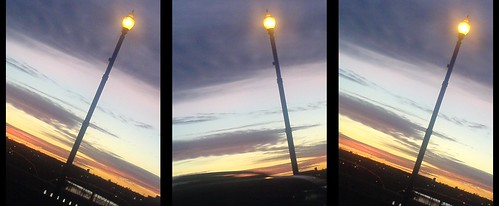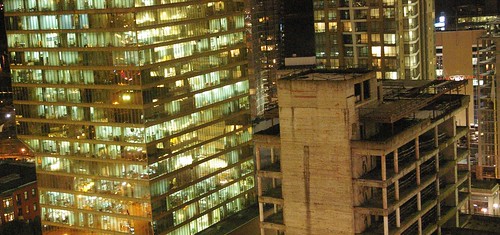Here are some pictures I took on my walk home this evening...






I love how everything looks lit by fluorescent lights.
Here is an older picture I took last year in Vancouver...











While Rachelle credits Vancouver-based artist Evan Lee and British artist Helen Chadwick with the technical inspiration behind the work, even more interesting is her imagery which alludes to various artistic genres and literature. Rachelle captures the morbid symbolism of 16th and 17th Century vanitas still life paintings with wilting flowers, rotting grapes, and an hourglass. The artist herself projects lifelessness by keeping her eyes firmly shut. The vanitas theme reminds the viewer that pleasure is futile and death is inevitable. Despite their foreboding qualities, the images remain undeniably beautiful and hint at a sexual tension. Blushing flower petals rustle open, suggesting a naughty peek under a woman’s shirt, and the flushed skin, tousled hair and parted lips of the artist’s face could be simultaneously interpreted as either qualities of the vanitas theme or lusty indulgences.
I felt that the work’s technique and style could refer to Evergon’s exotic Ramboy series and the recent, collaged photographs of Gilbert and George. I was subsequently reminded of Ophelia, one of Shakespeare’s most tragic heroines, and her mad descent into a watery grave. Most importantly however are Rachelle’s allusions to Lewis Carroll’s Alice in Wonderland books. Tiny tea spoons, white roses, seashells, and the infamously tardy white rabbit all appear to be accompanying Alice as she tumbles endlessly down the rabbit hole.
Joseph Anderson
Here are the six works I had in the show - Vanitas series







 What is most striking for me is that the print and embroidery seem to be more meaningful in her collections than the actual design of the clothing. The following picture is an example of embroidery on her clothing. Although the jacket is beautiful, it is overshadowed by the the bright embroidery. I do love how much colour she uses in her designs, and I love the playfulness of the prints she selects.
What is most striking for me is that the print and embroidery seem to be more meaningful in her collections than the actual design of the clothing. The following picture is an example of embroidery on her clothing. Although the jacket is beautiful, it is overshadowed by the the bright embroidery. I do love how much colour she uses in her designs, and I love the playfulness of the prints she selects.
















